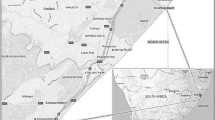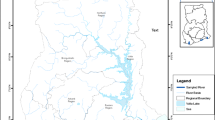Abstract
Fish and shellfish are regularly consumed and sold in Ghana, yet studies on arsenic pollution in Ghana are limited largely to ground water. This study evaluated arsenic concentrations in seven species of shellfish and 10 species of fish inhabiting the mouth of Ankobra, Densu and Volta basins in Ghana and assessed the public health implications. Arsenic levels varied from 0.2 to 2.2 mg L−1 in the three rivers and were higher than WHO recommended values of 10 μg L−1 for drinking water. Except for Periophthalmus sp. and Tympanotonus fuscatus from the Ankobra in which arsenic was not detected, concentrations in the organisms ranged from 0.2 to 2.8 mg kg−1. The maximum quantities of the organisms considered safe for consumption ranged from 375 to 5250 g per week. Caution however needs to be exercised as PTWI for arsenic needs revision, and some heavy metals such as mercury are more toxic than arsenic.


Similar content being viewed by others
Reference
Addy, S. N. (1998). Ghana: revival of the mineral sector. Resources Policy, 24, 229–239.
Afful, S., Anim, A. K., & Serfor-Armah, Y. (2010). Spectrum of organochlorine pesticide residues in fish samples from the Densu Basin. Research Journal of Environmental and Earth Sciences, 2, 133–138.
Amonoo-Neizer, E. H., & Amekor, E. M. K. (1993). Determination of total arsenic in environmental samples from Kumasi and Obuasi, Ghana. Environmental Health Perspectives, 101(1), 44–49.
Araújo, C. V. M., & Cedeño-Macias, L. (2016). Heavy metals in yellowfin tuna (Thunnus albacares) and common dolphinfish (Coryphaena hippurus) landed on the Ecuadorian coast. Science of the Total Environment, 541, 149–154.
Bissen, M., & Frimmel, F. H. (2003a). Arsenic—a review. Part I: occurrence, toxicity, speciation, and mobility. Acta Hydrochimica et Hydrobiologica, 31, 9–18.
Boamponsem, L.K. (2009). Heavy metals levels in lichens, soils, sediments and water bodies of teberebie and its environs in the Western Region of Ghana. Master Science Thesis, KNUST, Ghana. pp 149.
Dzigbodi-Adjimah, K., & Bansah, S. (1995). Current developments in placer gold exploration in Ghana: time and financial considerations. Exploration and Mining Geology, 4, 297–306.
EU Commission Regulation (2015/2016) Amending Regulation (EC) No 1881/2006 as regards maximum levels of inorganic arsenic in foodstuffs. http://eur-lex.europa.eu/legal-content/EN/TXT/PDF/?uri=CELEX:32015R1006&from=EN
FAO/WHO Expert Committee on Food Additives (2010) Seventy-second meeting of the JECFA. Summary and Conclusions, Rome, 16–25 February, pp 16.
FAO/WHO Expert Committee on Food Additives (2011) Evaluation of certain food additives and contaminants: Seventy-third report of the Joint FAO/WHO Expert Committee on Food Additives. WHO Technical Report Series; No 960, pp 228.
Gbogbo, F., & Otoo, D. S. (2015). The concentrations of five heavy metals in components of an economically important urban coastal wetland in Ghana: public health and phytoremediation implications. Environmental Monitoring and Assessment, 187(10), 655. doi:10.1007/s10661-015-4880-0.
Gbogbo, F., Oduro, W., & Oppong, S. (2008). Nature and pattern of lagoon fisheries resource utilisation and its implications for waterbird management in coastal Ghana. African Journal of Aquatic Science, 33, 211–222.
Gbogbo, F., Otoo, D. S., Huago, R. Q., & Asomaning, O. (2017). High levels of mercury in wetland resources from three river basins in Ghana: a concern for public health. Environmental Science and Pollution Research, 24(6), 5619–5627.
Ghana Government (2008) Ghana climate change impacts, vulnerability and adaptation assessment: Under the Netherlands Climate Assistance Programme (NCAP), Accra, Ghana.
Gibson, R. S., & Cage, L. A. (1982). Changes in hair arsenic levels in breast and bottle fed infants during the first year of infancy. Science of the Total Environment, 26, 33–40.
Grotti, M., Soggia, F., Lagomarsino, C., Goessler, W., & Francesconi, K. A. (2008). Arsenobetaine is a significant arsenical constituent of the red Antarctic alga Phyllophora antarctica. Environmental Chemistry, 5, 171–175.
Hunter, P. R., Zmirou-Navier, D., & Hartemann, P. (2009). Estimating the impact on health of poor reliability of drinking water interventions in developing countries. Science of the Total Environment, 407, 2621–2624.
Jain, K., & Ali, I. (2000). Arsenic: occurrence, toxicity and speciation techniques. Water Research, 34(17), 4304–4312.
Kusimi, J. M. (2008). Stream processes and dynamics in the morphology of the Densu river channel in Ghana. The International Archives of the Photogrammetry, Remote Sensing and Spatial Information Sciences, 37, 1177.
Mandal, B., & Suzuki, K. T. (2002). Arsenic round the world: a review. Talanta, 58, 201–235.
Ng, J. C. (2005). Environmental contamination of arsenic and its toxicological impact on humans. Environtal Chemistry, 2, 146–160.
NRS (National Residue Survey). (2012). NRS annual report 2010–11. Australian government (p. 272). Canberra: Department of Agriculture, Fisheries and Forestry.
Oguntunde, P. G., Friesen, J., van de Giesen, N., & Savenije, H. H. G. (2006). Hydroclimatology of the Volta River Basin in West Africa: trends and variability from 1901 to 2002. Physics and Chemistry of the Earth, 31, 1180–1188.
Olmedo, P., Pla, A., Hernández, A. F., Barbier, F., Ayouni, L., & Gil, F. (2013). Determination of toxic elements (mercury, cadmium, lead, tin and arsenic) in fish and shellfish samples. Risk assessment for the consumers. Environment Intertantional, 59, 63–72.
Ordiano-Flores, A., Galván-Magaña, F., & Rosiles-Martínez, R. (2011). Bioaccumulation of mercury in muscle tissue of yellowfin tuna, Thunnus albacares, of the eastern Pacific Ocean. Biological Trace Element Research, 144, 606–620.
Schaeffer, R., Francesconi, K. A., Kienzl, N., Soeroes, C., Fodor, P., Varadi, L., Raml, R., Goessler, W., & Kuehnelt, D. (2006). Arsenic speciation in freshwater organisms from the river Danube in Hungary. Talanta, 69(4), 856–865.
Sharma, V. K., & Sohn, M. (2009). Aquatic arsenic: toxicity, speciation, transformations, and remediation. Environment International, 35, 743–759.
Showers, K. B. (2002). Water scarcity and urban Africa: an overview of urban–rural water linkages. World Development, 30, 621–648.
WHO (World Health Organization). (2011). Arsenic in drinking-water: background document for development of WHO guidelines for drinking-water quality. Geneve: World Health Organization 16 pp.
Williams, P. N., Villada, A., Deacon, C., Raab, A., Figuerola, J., Green, A. J., Feldmann, J., & Meharg, A. A. (2007). Greatly enhanced arsenic shoot assimilation in rice leads to elevated grain levels compared to wheat and barley. Environmental Science and. Technology, 41, 6854–6859.
WRC (Water Resources Commission). (2003). Ghana raw water criteria and guidelines. In Domestic water (Vol. 1). Accra, Ghana: CSIR-Water Research Institute.
Acknowledgements
We acknowledge the support received from Mr. Prince Agbanyo, DABCS, University of Ghana, during the fieldwork. The contributions of Mr. Prince Owusu of the Ecological Laboratory, University of Ghana, and the staff of the Nuclear Chemistry and Environment Research Centre, Ghana Atomic Energy Commissions, cannot go unnoticed.
Author information
Authors and Affiliations
Corresponding author
Rights and permissions
About this article
Cite this article
Gbogbo, F., Otoo, S.D., Asomaning, O. et al. Contamination status of arsenic in fish and shellfish from three river basins in Ghana. Environ Monit Assess 189, 400 (2017). https://doi.org/10.1007/s10661-017-6118-9
Received:
Accepted:
Published:
DOI: https://doi.org/10.1007/s10661-017-6118-9




